

Maker Ed – Maker Education Initiative. MAKE STEAM: Giving Maker Education Some Context. As an experiential educator who has fully embraced technology as a means for allowing and facilitating learner voice, creativity, innovation, inventiveness, the Maker Education movement fits into my vision about what a good education entails.

I have been blogging and presenting about Maker Education – see But recent discussions with other educators and administrators made me realize that the idea of maker education is often vague and seems unrealistic in terms of regular classroom instruction. As such, in the future, I am going to associate and discuss Maker Education in the context S.T.E.A.M. – science, technology, engineering, arts (including language arts), math, hopefully, encouraging regular classroom teachers to integrate maker education projects into their classrooms. What follows are some resources and articles I compiled to provide educators as part of this discussion. Link to Thinglink that contains links to the following resources – Like this: Like Loading... Maker Ed's Resource Library. » Become a Sponsor Disclaimer: Maker Ed’s online Resource Library contains links to third-party organizations, companies, and commercial products.

By including these resources, Maker Ed intends to highlight their potential value to the maker education community, rather than to provide an endorsement. The library is independently managed by Maker Ed staff, who adhere to a set of guidelines to ensure that all third-party resources are primarily informational, rather than promotional, in nature. This resource curation process is free from the influence or control of any party outside of Maker Ed. SCOE: Resources: Instruction: 21st Century Learning: Maker Education.
We are pleased to announce that Sonoma County schools and districts interested in the Maker Education movement will now find new support and expertise for their efforts at SCOE.
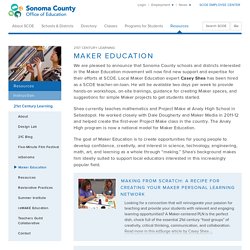
Local Maker Education expert Casey Shea has been hired as a SCOE teacher-on-loan. He will be available two days per week to provide hands-on workshops, on-site trainings, guidance for creating Maker spaces, and suggestions for simple Maker projects to get students started. Shea currently teaches mathematics and Project Make at Analy High School in Sebastopol.
He worked closely with Dale Dougherty and Maker Media in 2011-12 and helped create the first-ever Project Make class in the country. The Analy High program is now a national model for Maker Education. What’s in a MakerSpace? By Sylvia Libow Martinez and Gary S.
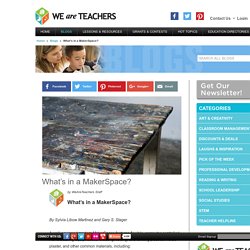
Stager. Maker Space In Education Series… 10 Sites To Start Making In The Classroom. Welcome back and I sure hope you enjoyed the last article of 20 Reasons for Maker Space in Education.
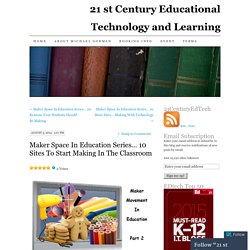
I hope you enjoy this post as I highlight 10 sites to possible help you to get Making in the classroom… even if in the smallest way! I encourage you to send me information and resources you think help with this idea, as I am also Making time to learn. First, to ensure you do not miss one of these valuable posts or other resources covering PBL, Digital Curriculum, Web 2.0, STEM, 21st century learning, and technology integration please sign up for 21centuryedtech by email or RSS.
As always, I invite you to follow me on twitter (@mjgormans). Please give this post a retweet and pass it on. Booking Info – Time to think about your new school year needs. Makers Space Series. Dissecting the Un-Makerspace: Recycled Learning. It starts with a twist, a squeak, and a cheer.
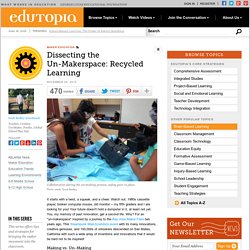
Watch out, 1980s cassette player, broken computer mouse, old monitor -- my fifth graders and I are looking for you! Your future doesn't hold a dumpster in it, at least not yet. You, my memory of past innovation, get a second life. Why? For an "un-makerspace" inspired by a journey to the Bay Area Maker Faire two years ago. Create a school makerspace in 3 simple steps. As maker education gains steam, many educators are looking for ways to incorporate making and tinkering into their schools and classrooms — often on a shoestring budget. “Kids are saying they want to learn more about technology and science, but they also want to experience it creatively and use it personally,” said Dale Dougherty, founder of Make Media, which produces Maker Faire and Make Magazine.
He’ll address how educators can deliver these types of experimental learning experiences during ISTE 2014’s EdTekTalks, a provocative series of mini-keynotes from thought leaders beyond the world of ed tech. “One of the ways we can do that is create more makerspaces for kids. Part of my talk will be leading the charge to say let’s build more makerspaces inside schools, libraries and even community centers.” Designing a School Makerspace. Makerspaces, STEAM labs and fab labs are popping up in schools across the country.
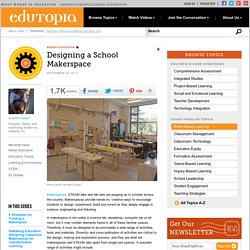
Resources for Creating a Makerspace. Are you ready to create your own Makerspace?
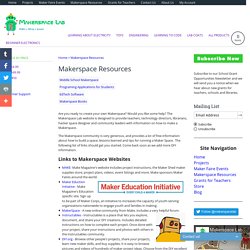
Would you like some help? The Makerspace Lab website is designed to provide teachers, technology directors, librarians, hacker space designer and community leaders with information on how to make a Makerspace. The Makerspace community is very generous, and provides a lot of free information about how to build a space, lessons learned and tips for running a Maker Space. The following list of links should get you started. Come back soon as we add more DIY information. Want to Start a Makerspace at School? Tips to Get Started.
As the Maker Movement starts to gain momentum, schools that are trying to find ways to foster the do-it-yourself environment can learn a few lessons from another nexus in the universe: public libraries.
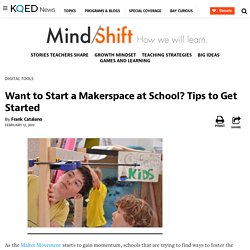
Dale Dougherty, founding editor and publisher of Make Magazine — and the de facto leader of the Maker Movement — has a vision to create a network of libraries, museums, and schools with what he calls “makerspaces” that draw on common resources and experts in each community. Libraries and museums, he said, are easier places to incorporate makerspaces than schools, because they have more space flexibility and they’re trying to attract teens with their programs.
“Schools have already got the kids,” Dougherty noted wryly, at the recent American Library Association Midwinter Meeting in Seattle. One day during the conference, dubbed Maker Monday, focused on the Maker Movement, which emphasizes learning by engaging in tech-related projects. “Why are you here?” How to Turn Any Classroom Into a Makerspace. There is a certain magic found in rolling up your sleeves and tackling a project head on, an undeniable sense of empowerment that results from solving problems and manifesting big ideas.
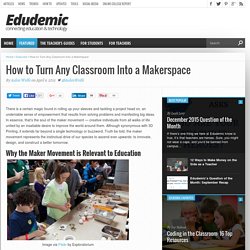
In essence, that’s the soul of the maker movement — creative individuals from all walks of life united by an insatiable desire to improve the world around them. Although synonymous with 3D Printing, it extends far beyond a single technology or buzzword. Starting a School Makerspace from Scratch. With the National Week of Making behind us, you might be ready to start a makerspace in your school -- but not know where to start. Will purchasing a costly 3D printer and the latest robotics kit ensure learning and maker success? What are some steps to starting a successful makerspace from scratch? Step 1: Immerse Yourself in Maker Education Before you can build your own community of makers, you need to join one! Immerse yourself in makerspaces by joining a summer maker camp like Exploratorium's Tinkering Fundamentals or the virtual Camp Google for cheap and easy STEM ideas, but most importantly: make stuff!
Curious about classroom Makerspaces? Here’s how to get started. Makerspace is a rapidly growing trend in schools across the country, but to be honest, I’ve never implemented one myself, and I can’t quite picture the logistics of orchestrating a Makerspace. How do kids know what to do? How can you find out what they’re learning? How do you make time for that with all the other tasks crammed into the school day? And how do you keep the Makerspace from turning into a chaotic mess? I wanted to get answers to these questions from teachers who have extensive Makerspace experience, and not just at the secondary level. Classroom Makerspace: Resources - Digital Harbor Foundation.
Creating an Authentic Maker Education Rubric. While many teachers are excited about the maker movement and may even be creating projects for their classrooms, assessment can be puzzling even to veteran classroom teachers. How can teachers prove that deep, rich learning is occurring through making? How do we justify a grade to students and parents alike, especially to the student who "just isn’t good at art"? By crafting a three-part rubric that assesses process, understanding, and product, teachers can rest assured that they are covering all the bases. Part 1: Process The process of making in the classroom needs to be incorporated in the final grade.
Photo credit: Lisa Yokana As part of a recent project in my school's senior-level public policy class, students crafted scale models of Lower Manhattan in preparation for a disaster simulation. Students created a scale model of Lower Manhattan in City 2.0 at Scarsdale High School. Part 2: Understanding Students must demonstrate an understanding of materials and tools. Habits of Mind. A Makerspace Built by Elementary Students. Edutopia.
Maker Education - About Maker Education. TheDadLab - kids science experiments - TheDadLab. Imagination.org – Global Cardboard Challenge. Toys from Trash. Teachers - Instructables. "Don't stop what you're doing!! " - J. Ward,Homeschooler "You guys are awesome! " - M.